Bessel–Gauss Beams of Arbitrary Integer Order: Propagation Profile, Coherence Properties, and Quality Factor
Abstract
:1. Introduction
2. Paraxial Wave Equation for Parabolic Media
2.1. Space of Solutions (Stationary and Guided LG Modes)
2.2. Subspaces with a Well-Defined Optical Angular Momentum
3. Guided Bessel–Gauss Modes as Generalized Coherent States
- Modified Bessel and Bessel profiles. For the functions consist of a modified Bessel function modulated by a Gaussian distribution of standard deviation . The latter accelerates the radial decay of the beam. Depending on the eigenvalue-phase , the function is interchanged by , and vice versa (the same occurs at specific points along the propagation axis, see details below).
- Contribution of the p-th harmonic. The most likely eigenvalue occurring in the superposition is determined by the expectation value . The helicity parameter ℓ is fixed, so the relevant information is encoded in the expectation value of the number operator . The straightforward calculation yields

3.1. Variances and Standard Deviations
3.2. Beam Quality
3.3. Propagation Properties
3.3.1. Behavior for Real Eigenvalues
- Initial configuration and periodicity. Considering as the point of departure, the initial configuration of the beam is recovered at the points , with , see Figure 5. At any of these points, the Bessel function is real-valued and exhibits a denumerable set of zeros. The latter defines a radial distribution of the phase plane where produces a phase shift . In turn, the polar variable sweeps times the interval in every one of the regions defined by the sign of .
- Self-focusing. A second class of interesting points distributed along the propagation axis is defined by the rule , with . The self-focus of the field is produced twice in each period , just at the points of the propagation axis, see Figure 5.
- Maximum spreading of the beam. At the points , with , the coherent state changes its profile from the Bessel function of the first kind to the modified Bessel function . The latter yields the maximum radial uncertainty of the beam. The intensity distribution is blurred on the transverse plane, and the phase distribution occurs without the radial distribution of the previous cases (the Bessel function has no zeros along the real axis of the complex u-plane if is an integer [43]). Figure 8 and Figure 9 show the transverse intensity and phase distribution for and , respectively.
- Vortices. At any other point of the propagation axis, the Bessel function appearing in (10) is complex-valued. Thus, contributes to the global phase of with a term that depends on in general. As a consequence, the phase distribution of the initial configuration is distorted such that it exhibits vortices. This is illustrated in Figure 10 for , the real and imaginary parts of change sign in different regions of the transverse plane. The phase distribution is, therefore, characterized by the quotient of such signs.
3.3.2. Behavior for Pure Imaginary Eigenvalues
4. Discussion
5. Conclusions
- ∘
- The maximum transverse-spreading of any BG mode is parameterized by . The shorter the value of , the better the collimation of the corresponding beam.
- ∘
- The quality of the BG modes is also parameterized by : the shorter the value of , the closer the BG modes are to the Gaussian profile.
- ∘
- The optical angular momentum spoils the beam quality: poor beam quality results for large , no matter how small is.
- ∘
- The fundamental LG mode is dominant in any superposition intended to build high-quality BG modes. The contribution of the remaining LG modes can be treated as a disturbance (noise) that deviates the BG mode from the ideal Gaussian profile.
- ∘
- The profile of the BG mode is for , and for .
- ∘
- No matter the value of , the profile of the BG modes changes periodically from to as the beam propagates along the z-axis.
- ∘
- The transverse-spreading of the BG modes is always finite and changes periodically from its maximum value to its minimum value at very specific points along the propagation axis.
- ∘
- At any other point of the propagation axis, the phase distribution of the BG modes exhibits vortices.
Author Contributions
Funding
Institutional Review Board Statement
Informed Consent Statement
Data Availability Statement
Acknowledgments
Conflicts of Interest
Appendix A. The Irreducible Representation Space of the Lie Algebra
- (i)
- The ensemble is in one-to-one correspondence with the energy spectrum of the 2D quantum oscillator.
- (ii)
- The square integrability condition for quantum bound states corresponds to finite transverse optical power for localized optical beams [24].
References
- Barnett, S.M.; Babiker, M.; Padgett, M.J. Optical orbital angular momentum. Philos. Trans. R. Soc. A 2017, 375, 20150444. [Google Scholar] [CrossRef]
- Yao, A.M.; Padgett, M.J. Orbital angular momentum: Origins, behavior and applications. Adv. Opt. Photonics 2011, 3, 161–204. [Google Scholar] [CrossRef]
- Barnett, S.M.; Babiker, M.; Padgett, M.J. (Eds.) Theme Issue “Optical Orbital Angular Momentum”; Royal Society: London, UK, 2017; Volume 375. [Google Scholar]
- Allen, L.; Beijersbergen, M.W.; Spreeuw, R.J.C.; Woerdman, J.P. Orbital angular momentum of light and the transformation of Laguerre-Gaussian laser modes. Phys. Rev. A 1992, 45, 8185–8189. [Google Scholar] [CrossRef]
- He, H.; Friese, M.E.J.; Heckenberg, N.R.; Rubinsztein-Dunlop, H. Direct Observation of Transfer of Angular Momentum to Absorptive particles from a Laser Beam with a Phase Singularity. Phys. Rev. Lett. 1995, 75, 826–829. [Google Scholar] [CrossRef] [PubMed]
- Allen, L.; Padgett, M.J. The Poynting vector in Laguerre-Gaussian beams and the interpretation of their angular momentum density. Opt. Commun. 2000, 184, 67–71. [Google Scholar] [CrossRef]
- Padgett, M.; Allen, L. Light with a twist in its tail. Contemp. Phys. 2000, 41, 275–285. [Google Scholar] [CrossRef]
- Barnett, S.M. Optical angular momentum flux. J. Opt. B Quantum Semiclass Opt. 2002, 4, S7–S16. [Google Scholar] [CrossRef]
- Chaturvedi, A.S.; Mukunda, N. On ‘Orbital’ and ‘Spin’ Angular Momentum of Light in Classical and Quantum Theories—A General Framework. Fortschr. Phys. 2018, 66, 1800040. [Google Scholar]
- Bazhenov, V.Y.; Soskin, M.S.; Vasnetsov, M.V. Screw dislocations in light wavefronts. J. Mod. Opt. 1992, 39, 985–990. [Google Scholar] [CrossRef]
- Beijersbergen, M.W.; Allen, L.; van der Veen, H.E.L.; Woerdman, J.P. Astigmatic mode converters of orbital angular momentum. Opt. Commun. 1993, 96, 123–132. [Google Scholar] [CrossRef]
- Arlt, J.; Dholakia, K.; Allen, L.; Padgett, M.J. The production of multiringed Laguerre-Gaussian modes by computer-generated holograms. J. Mod. Opt. 1997, 45, 1231–1237. [Google Scholar] [CrossRef]
- Ngcobo, S.; Aït-Ameur, K.; Passilly, N.; Hasnaoui, A.; Forbes, A. Exciting higher-order radial Laguerre-Gaussian modes in a dipole-pumped solid-state laser resonator. Appl. Opt. 2013, 52, 2093–2101. [Google Scholar] [CrossRef] [PubMed]
- Forbes, A.; Dudley, A.; McLaren, M. Creation and detection of optical modes with spacial light modulators. Adv. Opt. Photonics 2016, 8, 200–227. [Google Scholar] [CrossRef]
- Cruz y Cruz, S.; Escamilla, N.; Velázquez, V. Generation of Sources of Light with Well Defined Orbital Angular Momentum. J. Phys. Conf. Ser. 2016, 698, 012016. [Google Scholar] [CrossRef]
- Cruz y Cruz, S.; Gress, Z.; Jiménez-Macías, P.; Rosas-Ortiz, O. Laguerre-Gaussian Wave propagation in Parabolic Media. In Geometric Methods in Physics XXXVIII; Trends in Mathematics Birkhäuser: Cham, Switzerland, 2020; pp. 117–128. [Google Scholar]
- Gress-Mendoza, Z.; Cruz y Cruz, S.; Velázquez, V. Production and Characterization of Helical Beams by means of Diffraction Gratings. J. Phys. Conf. Ser. 2023, 2448, 012017. [Google Scholar] [CrossRef]
- Willner, A.E.; Ren, Y.; Xie, G.; Yan, Y.; Li, L.; Zhao, Z.; Wang, J.; Tur, M.; Molisch, A.F.; Ashrafi, S. Recent advances in high-capacity free-space optical and radio-frequency communications using orbital angular momentum multiplexing. Philos. Trans. R. Soc. A 2017, 375, 20150439. [Google Scholar] [CrossRef] [PubMed]
- Russell, P.S.; Beravat, R.; Wong, G.K.L. Helically twisted photonic crystal fibres. Philos. Trans. R. Soc. A 2017, 375, 20150440. [Google Scholar] [CrossRef]
- Krenn, M.; Malik, M.; Erhard, M.; Zeilinger, A. Orbital angular momentum of photons and the entanglement of Laguerre-Gaussian modes. Philos. Trans. R. Soc. A 2017, 375, 20150442. [Google Scholar] [CrossRef]
- Yang, Y.; Ren, Y.-X.; Chen, M.; Arita, Y.; Rosales-Guszmán, C. Optical trapping with structured light: A review. Adv. Photonics 2021, 3, 034001. [Google Scholar] [CrossRef]
- Kotlyar, V.V.; Kovalev, A.A.; Nalimov, A.G. Propagation of hypergeometric laser beams in a medium with a parabolic refractive index. J. Opt. 2013, 15, 125706. [Google Scholar] [CrossRef]
- Petrov, N.I. Spin-Dependent Transverse Force on a Vortex Light Beam in an Inhomogeneous Medium. JETP Lett. 2016, 13, 443–448. [Google Scholar] [CrossRef]
- Cruz y Cruz, S.; Gress, Z. Group approach to the paraxial propagation of Hermite-Gaussian modes in a parabolic medium. Ann. Phys. 2017, 383, 257–277. [Google Scholar] [CrossRef]
- Wu, Y.; Wu, J.; Lin, Z.; Fu, X.; Qiu, H.; Chen, K.; Deng, D. Propagation properties and radiation forces of the Hermite-Gaussian vortex beam in a medium with a parabolic refractive index. Appl. Opt. 2020, 59, 8342–8348. [Google Scholar] [CrossRef] [PubMed]
- Puttnam, B.J.; Rademacher, G.; Luís, R.S. Space-division multiplexing for optical fiber communications. Optica 2021, 8, 1186–1203. [Google Scholar] [CrossRef]
- Siegman, A.E. Lasers; California University Science Books: Melville, NY, USA, 1986. [Google Scholar]
- Durnin, J. Exact solutions for nondiffracting beams I The scalar theory. J. Opt. Soc. Am. A 1987, 4, 651. [Google Scholar] [CrossRef]
- Durnin, J.; Miceli, J.; Eberly, J. Diffraction-free beams. Phys. Rev. Lett. 1987, 58, 1499. [Google Scholar] [CrossRef] [PubMed]
- Gori, F.; Guattari, G.; Padovani, C. Bessel-Gauss beams. Opt. Commun. 1987, 64, 491. [Google Scholar] [CrossRef]
- Bagini, V.; Frezza, F.; Santarsiero, M.; Schettini, G.; Schirripa Spagnolo, G. Generalized Bessel-Gauss beams. J. Mod. Opt. 1996, 43, 1155–1166. [Google Scholar]
- Borghi, R.; Santarsiero, M. M2 factor of Bessel-Gauss beams. Opt. Lett. 1997, 22, 262–264. [Google Scholar] [CrossRef]
- Li, Y.; Lee, H.; Wolf, E. New generalized Bessel-Gaussian beams. J. Opt. Soc. Am. A 2004, 21, 640–646. [Google Scholar] [CrossRef]
- Stoyanov, L.; Stefanov, A.; Dreischuh, A.; Paulus, G.G. Gouy phase of Bessel-Gaussian beams: Theory vs. experiment. Opt. Express 2023, 31, 13683–13699. [Google Scholar] [CrossRef]
- Wolf, K.B. Diffraction-Free Beams Remain Diffraction Free under All Paraxial Optical Transformations. Phys. Rev. Lett. 1988, 60, 757–759. [Google Scholar] [CrossRef] [PubMed]
- Uehara, K.; Kikuchi, H. Generation of Nearly Diffraction-Free Laser Beams. Appl. Phys. B 1989, 48, 125–129. [Google Scholar] [CrossRef]
- Overfelt, P.L. Bessel-Gauss pulses. Phys. Rev. A 1991, 44, 3941–3947. [Google Scholar] [CrossRef] [PubMed]
- Wang, T.-L.; Gariano, J.A.; Djordjevic, I.B. Employing Bessel-Gaussian Beams to Improve Physical-Layer Security in Free-Space Optical Communications. IEEE Photonics J. 2018, 10, 7907113. [Google Scholar] [CrossRef]
- Wang, W.; Zhang, G.; Ye, T.; Wu, Z.; Bai, L. Scintillation of the orbital angular momentum of a Bessel-Gaussian beam and its application on multi-parameter multiplexing. Opt. Express 2023, 31, 4507–4520. [Google Scholar] [CrossRef]
- Doster, T.; Watnik, A.T. Laguerre-Gauss and Bessel-Gauss beams propagation through turbulence: Analysis of channel efficiency. Appl. Opt. 2016, 55, 10239–10246. [Google Scholar] [CrossRef]
- Gress, Z.; Cruz y Cruz, S. A Note on the Off-Axis Gaussian Beams Propagation in Parabolic Media. J. Phys. Conf. Ser. 2017, 839, 012024. [Google Scholar] [CrossRef]
- Gress, Z.; Cruz y Cruz, S. Hermite Coherent States for Quadratic Refractive Index Optical Media, In Integrability, Supersymmetry and Coherent States; Kuru, S., Negro, J., Nieto, L.M., Eds.; CRM Series in Mathematical Physics; Springer: Berlin/Heidelberg, Germany, 2019; pp. 323–339. [Google Scholar]
- Olver, F.W.J.; Lozier, D.W.; Boisvert, R.F.; Clark, C.W. (Eds.) NIST Handbook of Mathematical Functions; Cambridge University Press: Cambridge, UK, 2010. [Google Scholar]
- Siegman, A.E. New developments in laser resonators. SPIE 1990, 1224, 1. [Google Scholar]
- Siegman, A.E. Defining, measuring, and optimizing laser beam quality. SPIE 1993, 1868, 1. [Google Scholar]
- Bélanger, P.-A.; Champagne, Y.; Paré, C. Beam propagation factor of diffracted laser beams. Pot. Commun. 1994, 105, 233. [Google Scholar] [CrossRef]
- Saleh, B.E.A.; Teich, M.C. Fundamentals of Photonics, 2nd ed.; John Wiley: Hoboken, NJ, USA, 2007. [Google Scholar]
- Glauber, R.J. Quantum Theory of Optical Coherence; Selected Papers and Lectures; Wiley-VCH: Weinheim, Germany, 2007. [Google Scholar]
- Rosas-Ortiz, O. Coherent and Squeezed States: Introductory Review of Basic Notions, Properties, and Generalizations. In Integrability, Supersymmetry and Coherent States; Kuru, S., Negro, J., Nieto, L.M., Eds.; CRM Series in Mathematical Physics; Springer: Berlin/Heidelberg, Germany, 2019; pp. 187–230. [Google Scholar]
- Barut, A.O.; Girardello, L. New “coherent” states associated with non-compact groups. Commun. Math. Phys. 1971, 21, 41. [Google Scholar] [CrossRef]
- Gradshteyn, I.S.; Ryzhik, I.M. Table of Integrals, Series, and Products, 7th ed.; Academic Press: Burlington, MA, USA, 2007. [Google Scholar]
- Robertson, H.P. The Uncertainty Principle. Phys. Rev. 1929, 34, 163. [Google Scholar] [CrossRef]
- Kennard, E.H. Zur quanten mechanik einfacher bewegungstypen. Z. Phys. 1929, 44, 326. [Google Scholar] [CrossRef]
- Gloge, D.; Marcuse, D. Formal Quantum Theory of Light Rays. J. Opt. Soc. Am. 1969, 59, 1629. [Google Scholar] [CrossRef]
- Stoler, D. Operator methods in physical optics. J. Opt. Soc. Am. A 1981, 71, 334. [Google Scholar] [CrossRef]
- Schrödinger, E. E Zum Heisenberschen Unsch"afprinzip. Ber. Kgl. Akad. Wiss. Berlin 1930, 24, 296. [Google Scholar]
- Bandres, M.A.; López-Mago, D.; Gutérrez-Vega, J.C. Higher order moments and overlaps of rotationally symmetric beams. J. Opt. 2010, 12, 015706. [Google Scholar] [CrossRef]
- Martínez-Herrero, R.; Manjavacas, A. Overall second-order parametric characterization of light beams propagating through spiral phase elements. Opt. Commun. 2009, 282, 473. [Google Scholar] [CrossRef]
- Dodonov, V.V.; Man’ko, O.V. Universal invariants of quantum-mechanical and optical systems. J. Opt. Soc. Am. A 2000, 17, 2403. [Google Scholar] [CrossRef] [PubMed]
- Perelomov, A. Generalized Coherent States and Their Applications; Springer: Berlin, Germany, 1986. [Google Scholar]
- Beuton, R.; Chimier, B.; Quinoman, P.; González Alaiza de Martínez, P.; Nuter, R.; Duchateau, G. Numerical studies of dielectric material modifications by a femtosecond Bessel-Gauss laser beam. Appl. Phys. A 2021, 127, 334. [Google Scholar] [CrossRef]
- Baltrukonis, J.; Ulčinas, O.; Orlov, S.; Jukna, V. High-Order Vector Bessel-Gauss Beams for Laser Micromachining of Transparent Materials. Phys. Rev. Appl. 2021, 16, 034001. [Google Scholar] [CrossRef]
- Harb, J.; Talbot, L.; Petit, Y.; Bernier, M.; Canioni, L. Demonstration of Type A volume Bragg gratings inscribed with a femtosecond Gaussian-Bessel laser beam. Opt. Express 2023, 31, 15736–15746. [Google Scholar] [CrossRef] [PubMed]
- Miller, J.K.; Tsvetkov, D.; Terekhov, P.; Litchinitser, N.M.; Dai, K.; Free, J.; Johnson, E.G. Spatio-temporal controlled filamentation using higher order Bessel-Gaussian beams integrated in time. Opt. Express 2021, 29, 19362–19372. [Google Scholar] [CrossRef]
- McLaren, M.; Agnew, M.; Leach, J.; Roux, F.S.; Padgett, M.J.; Boyd, R.W.; Forbes, A. Entangled Bessel-Gaussian Beams. Opt. Express 2012, 20, 23589–23597. [Google Scholar] [CrossRef]
- Finney, R.L.; Ostberg, D.R. Elementary Differential Equations with Linear Algebra; Addison-Wesley: Boston, MA, USA, 1976. [Google Scholar]
- Negro, J.; Nieto, L.M.; Rosas-Ortiz, O. Confluent hypergeometric equations and related solvable potentials in Quantum Mechanics. J. Math. Phys. 2000, 41, 7964. [Google Scholar] [CrossRef]
- Negro, J.; Nieto, L.M.; Rosas-Ortiz, O. Refined Factorizations of Solvable Potentials. J. Phys. A Math. Gen. 2000, 33, 7207. [Google Scholar] [CrossRef]
- deLange, O.L.; Raab, R.E. Operator Methods in Quantum Mechanics; Clarendon Press: Oxford, UK, 1992. [Google Scholar]
- Miller, W. Lie Theory and Special Functions; Academic Press: New York, NY, USA, 1968. [Google Scholar]
- Gilmore, R. Lie Groups, Lie Algebras and Some of Their Applications; Kriege: Malabar, FL, USA, 1994. [Google Scholar]
- Infeld, L.; Hull, T.E. The Factorization Method. Rev. Mod. Phys. 1951, 23, 21. [Google Scholar] [CrossRef]
- Mielnik, B.; Rosas-Ortiz, O. Factorization: Little or great algorithm? J. Phys. A Math. Gen. 2004, 37, 10007. [Google Scholar] [CrossRef]
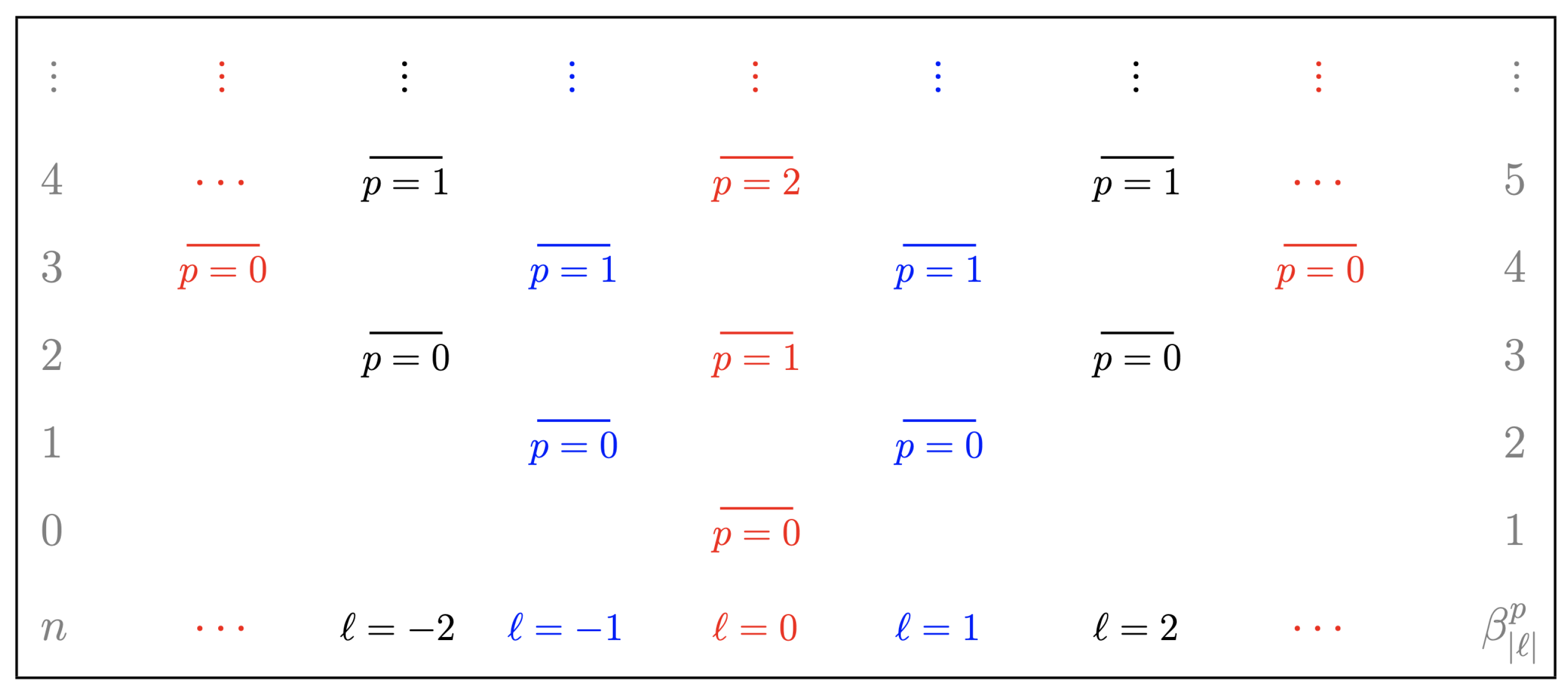

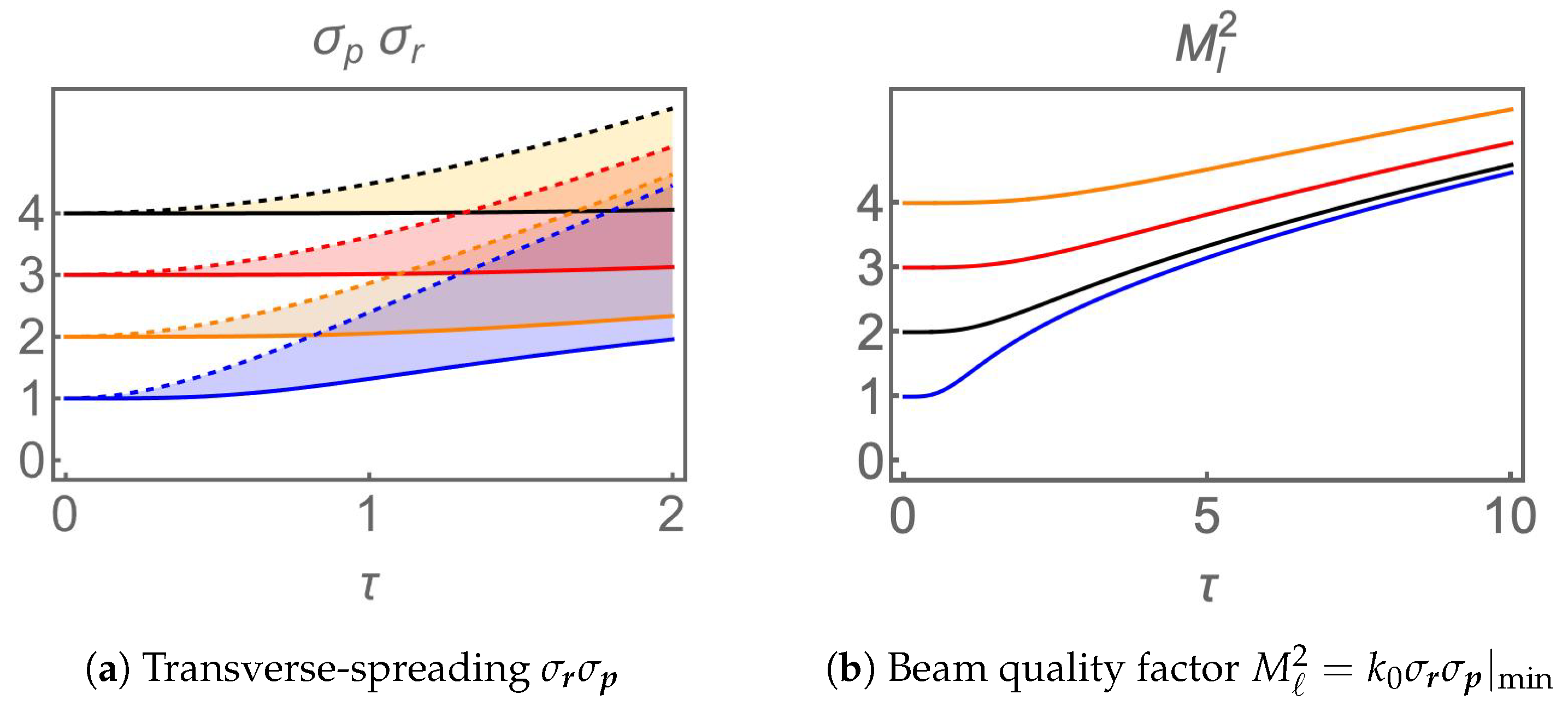
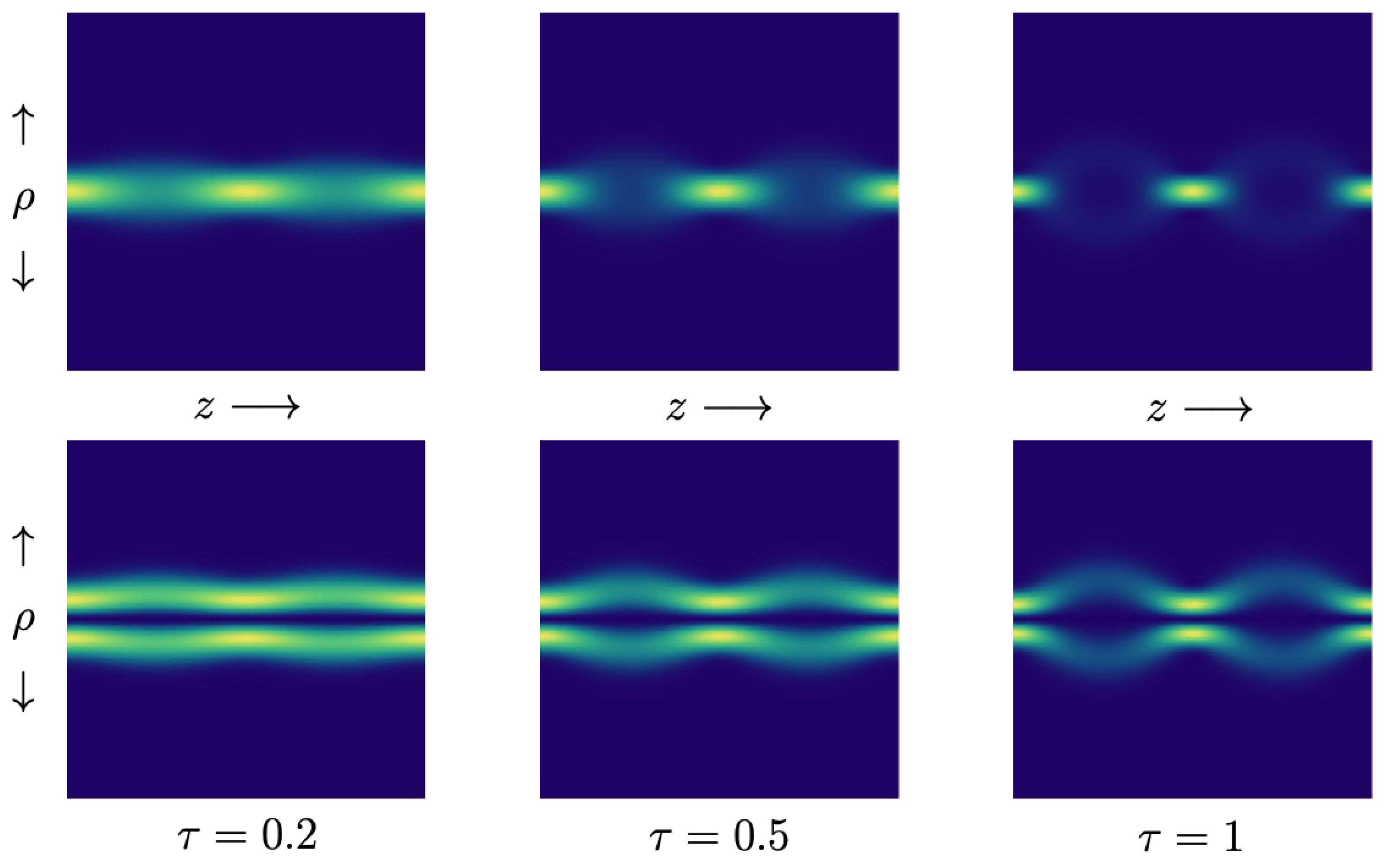
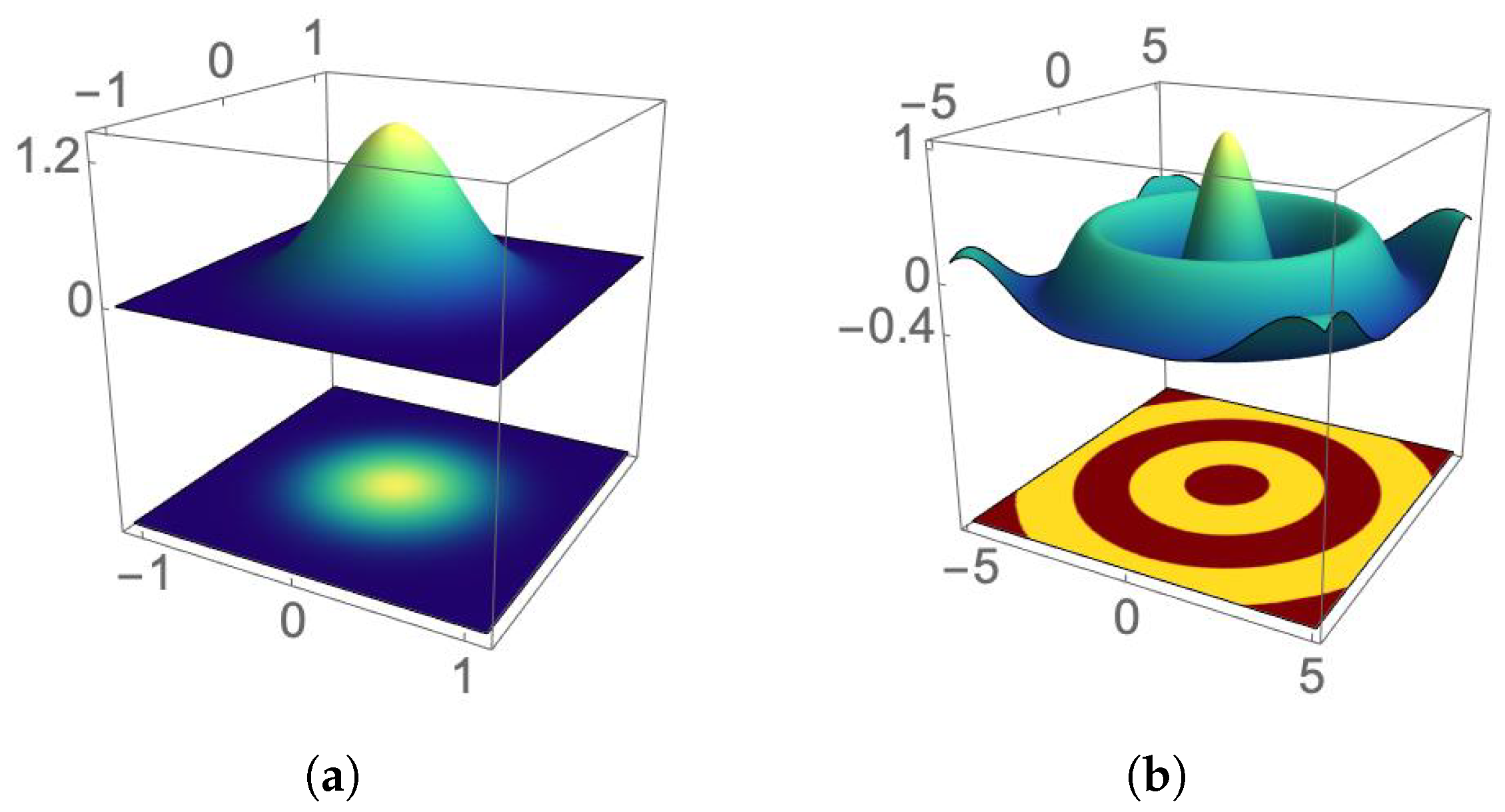





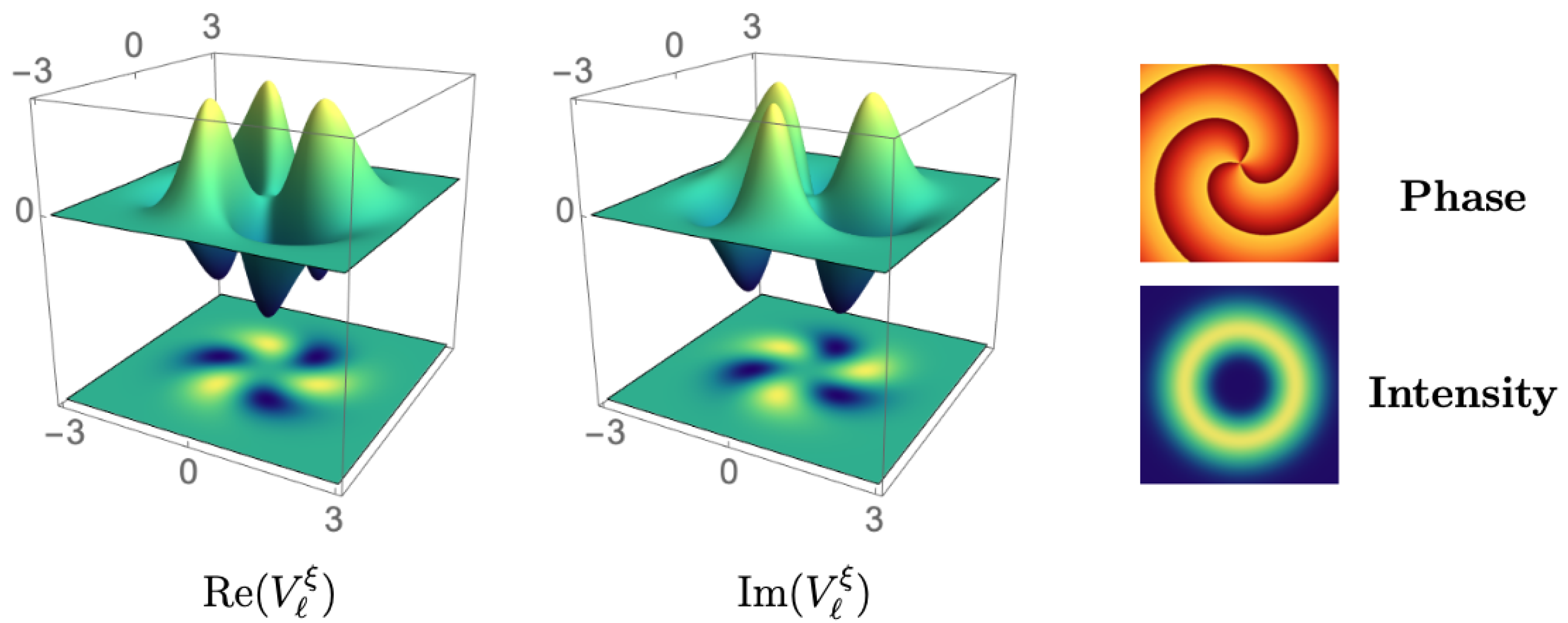
| 1/2 | 1 | 3/2 | 2 | |
| 3/2 | 2 | 5/2 | 3 | |
| 5/2 | 3 | 7/2 | 4 | |
| 7/2 | 4 | 9/2 | 5 |
Disclaimer/Publisher’s Note: The statements, opinions and data contained in all publications are solely those of the individual author(s) and contributor(s) and not of MDPI and/or the editor(s). MDPI and/or the editor(s) disclaim responsibility for any injury to people or property resulting from any ideas, methods, instructions or products referred to in the content. |
© 2023 by the authors. Licensee MDPI, Basel, Switzerland. This article is an open access article distributed under the terms and conditions of the Creative Commons Attribution (CC BY) license (https://creativecommons.org/licenses/by/4.0/).
Share and Cite
Cruz y Cruz, S.; Gress, Z.; Jiménez-Macías, P.; Rosas-Ortiz, O. Bessel–Gauss Beams of Arbitrary Integer Order: Propagation Profile, Coherence Properties, and Quality Factor. Photonics 2023, 10, 1162. https://doi.org/10.3390/photonics10101162
Cruz y Cruz S, Gress Z, Jiménez-Macías P, Rosas-Ortiz O. Bessel–Gauss Beams of Arbitrary Integer Order: Propagation Profile, Coherence Properties, and Quality Factor. Photonics. 2023; 10(10):1162. https://doi.org/10.3390/photonics10101162
Chicago/Turabian StyleCruz y Cruz, Sara, Zulema Gress, Pedro Jiménez-Macías, and Oscar Rosas-Ortiz. 2023. "Bessel–Gauss Beams of Arbitrary Integer Order: Propagation Profile, Coherence Properties, and Quality Factor" Photonics 10, no. 10: 1162. https://doi.org/10.3390/photonics10101162
APA StyleCruz y Cruz, S., Gress, Z., Jiménez-Macías, P., & Rosas-Ortiz, O. (2023). Bessel–Gauss Beams of Arbitrary Integer Order: Propagation Profile, Coherence Properties, and Quality Factor. Photonics, 10(10), 1162. https://doi.org/10.3390/photonics10101162





